- Home
- Tony Hillerman
Seldom Disappointed: A Memoir Page 20
Seldom Disappointed: A Memoir Read online
Page 20
The other problems were human. Three units held soldiers based at Fort Sill, the other three Morning Press staffers. The newsmen went to work about noon and returned about 1 A.M. to talk, dine, and tell jokes. The soldiers left for duty about 7 A.M. and returned late afternoon. We were getting reacquainted with our wives in the wee hours while the soldiers were trying to sleep. They were shooing their tricycling tots out into the courtyard about 9 A.M. when we were trying to sleep. How was the insulation? Through the thin sheet of plywood separating our bathrooms, I could hear the sound of my neighbor’s razor blade scraping off his whiskers.
The above and the impending arrival of our daughter started us house hunting again. We lucked (our luck perhaps helped by buying an endowment policy from the landlord) on to a one-bedroom duplex, which Marie still remembers as “heavenly.” Anne arrived, a lovely little girl afflicted with colic for what seemed like forever, and we were able to bring her home from the hospital into a house on a street with actual lawns (a first for us). Just about then the long hours, hard work of our rookie staff, and savvy editorial direction of Frank Hall began paying off. We were beating the staid Constitution on stories, our circulation was way up, the big advertisers were beginning to buy big advertising space. Being rookies in the newspaper game we thought this might produce pay raises. The following happened:
I was doing my late evening chores putting pages together when in walked Emmett Keough, the dreaded managing editor of the despised Constitution. He walked past me with a nod and disappeared into the office of Hall. The always noisy newsroom fell silent. This was as unthinkable as Yasser Arafat dropping in on a Jewish Anti-Defamation League banquet. There was no socializing between these two papers. We ate at different coffee shops, drank at different bars, ignored one another at news conferences. The rivalry was fierce and personal. After some nervous moments, the editor’s door opens, both editors emerge, Keough departs and our editor hands me a page of typescript. “Run it on the front page,” he says. “Put it below the fold with a two-column head.”
He had already written the headline. It said:
CONSTITUTION-PRESS MERGE
Which the story under the headline repeated. In other words, we had been sold to the opposition. We had lost the battle. No. We had won. It finally seeped into our innocent skulls that we were the front-line troops in a fairly typical example of capitalism in action. Our goal was to cut the Constitution’s profits deeply enough to make buying us out cheaper than competing. Anyway, the war was over and who needs soldiers with no battle to fight? Termination pay? Not in 1950. Two weeks notice? Nope. As I remember, three of us were offered jobs on the morning edition of the merged paper and all three swallowed our tattered pride and accepted.
For me, it meant a raise up to $75 a week. More important, it moved me from a newspaper served by United Press on to an Associated Press–member newspaper. United Press did not raid its clients’ newsrooms when needing people. It raided AP papers. Thus after I worked a bit for the merged paper I got a call from Carter Bradley, the UP manager for Oklahoma, and became a member of “The Hold Down Club,” a member of the American Newspaper Guild, and for the first (and last) time in my life I had a five-day, forty-hour work week, plus a two-week paid vacation.
Marie, baby Anne, and I moved to Oklahoma City and started house hunting again—for our fifth residence in two years of married life. We moved into an apartment just across the state’s busiest highway from Tinker Air Force Base and soon learned those huge buildings across the base fence housed “run-up pens” where jet aircraft engine repairs were tested at night by gunning them to their screaming, screeching, top horsepower. It didn’t matter as much as that suggests, however, because Anne’s colic persisted and her stomachache howls drowned out the engine noise.
Now I had a job that might lead somewhere. I took a pay cut down to $62.50 a week to get it, but a raise was due in a month and future raises were automatic. We started looking for an actual house and found it, just finished in a new housing addition—genuine brick with the garage poked out toward the street so the kitchen could be built behind it. It had a combined living room-dining room, a bedroom, and a bath. A ceiling fan offset the lack of air conditioning and there was space in back for a garden. The price was $9,100—and we both can still recall our nervousness at that deep plunge into debt.
It was the summer of 1951. I had worked on three newspapers, reported everything—a cattle-killing blizzard, multideath traffic smash, oil workers’ strike, murder trial, tornado, church fire, county commission meeting, election campaigns. I felt pretty good about my writing. But in the United Press Bureau in Oklahoma City I had dropped into a den of bona fide pros—a territory where the 11 A.M. deadline was replaced by the “Deadline every minute” rule of Hugh Bailey, the legendary whip-cracking czar of “Hold Down” country.
The few newsrooms I’ve been in since computers took over from teletype machines have seemed eerily quiet, more like a nest of accountants and lawyers than reporters. The newsrooms I remember from the fifties had been noisy, lots of yelling back and forth over the clacking of multiple teletypes, sounds of jubilation, despair, imprecations, jokes, camaraderie, and arguments. The song sung in the UP newsroom was dominated by the nervous chatter of teletypes as the dominant sound—the state wire, the trunk, the market wire, the sports wire, the radio wires. Each machine was delivering something that needed attention, was waiting in dreadful silence for you to feed it with something new, or was producing the Ding, Ding, which signaled the need was extremely urgent. No time for yelling, kidding around, assorted newsroom horseplay. The client in Tulsa wanted the story he’d requested and wanted it now. The division manager in Dallas needed an update on a sports story, and the time to file the noon newscasts was only seventeen seconds away. Now and then came a message from our nerve center, signed NX HB. NX was New York, and HB was Hugh Bailey himself. The Hank Browns, Hobson Belamies, and Horace Bungs of UP had to assign themselves other initials. HB meant the boss and we presumed he was the reason United Press had earned the title of Hold Down Club, since his proclamations tended to include an order to “hold down expenses.”
But Hugh Bailey was invisible, half a continent away. In our bureau the boss was Carter Bradley, the most astute newsman I’ve ever known. He was also the least patient—as I started learning about five minutes into the job. I strode into the bureau and announced my arrival, expecting to be welcomed and introduced around as a new member of the team. Everybody was talking on the telephone, or rattling away at a teletype, or doing both. I stood waiting recognition. Another telephone rang. Bradley looked at me, frowned, nodded toward the phone. I picked it up and said “United Press.”
“Stockers,” the voice said. “Three hundred forty. Seventeen ten to eighteen. Bred heifers, too few to price . . .”
“Hold it,” said I, grabbed a pencil and copy paper, and began jotting down the mid-morning cattle price quotations from the Oklahoma City stockyards. By now Bradley was off the phone, watching me, expression baleful. “Use your head,” he said. “Type calls like that right into the teletype tape. Saves the time of doing it twice.”
The basic and all-important skill of being a journalist (as opposed to being a writer) is information collection—and that was the area of Bradley’s genius. It’s not just a matter of knowing who has the information, it’s knowing who will share it with you. For example, we hear on our police scanner a twin-engine plane has crashed in the mountains near the Arkansas border. Bradley puts me on it. I call the Oklahoma Highway Patrol, who have information but aren’t in the mood to release it until the shift commander is ready to speak. I call the appropriate sheriff’s office. Same story. I call the hospital at the nearest town. No luck. I tell Bradley whom I’ve called and that all I have is a general location back in the heavy timbered roadless high country and that rescuers have reached the scene. Bradley rewards me with a dour look, says, “Call the Forest Service.” I do. The ranger has the same information as had the OHP, the
sheriff’s office, and the hospital. The difference is his work gives him scant chance to talk to the press and he’s delighted to see himself quoted. Therefore while the competition is fruitlessly calling the obvious officials, we are filing a story reporting seven dead and no survivors in the crash of an Air Force “trainer” plane.
This story also demonstrated the drawback of this system. The Associated Press (code-named “Grandma” by the other wire services because of its policy of being slow but sure) subsequently announced six dead and we had to file a correction reporting one of the bodies we’d reported was that of the colonel’s pet Doberman.
Bradley’s acute sense of where to get information when the bureaucrats were declining to comment earned KO (the Oklahoma City bureau’s code) a remarkable record on the monthly NX (New York) report card on “play” among the big-city papers, which had a choice between using UP, AP, or the International News Service. Bradley’s policy was to get our story on the papers news desks first and with the best lead paragraph. When we didn’t Bradley was not pleased. While Bradley was trying to teach me the skills of information retrieval, I was finding that I still had a lot to learn about writing from Phil Dessauer, the newswire editor, and Howard Wilson, our man at the state capital, was instructing me in the arcane science of reporting politics. Dessauer, a fine writer himself, went about his duties with tact, understanding the tender egos of learners. “Good piece here,” Dessauer would say after I’d handed him a six-hundred worder on a kidnap-murder trial. “See if you can do it in two hundred and fifty.” You’d find, of course, that you could cut out half of your prose, bad for the ego but good if you’re trying to learn how to master the language. Wilson was a genius at finding leaks, at getting politicians and bureaucrats to talk when their best interest told them silence was wiser, and at learning what (and who) the special interest lobbyists had up their sleeves.
I was the second-stringer at the capital, covering the Senate when the legislature was in session (the important things happened in the House), and helping out when Wilson was assigned to special stuff. I had the good fortune to be spotted by Otis Sullivan, the long-time dean of the pressroom, as one of his kind—a farm boy. Sullivan ran coverage of politics for the Daily Oklahoman, wrote its stolidly right-wing capital commentary column, and had something to say about the paper’s relentlessly regressive editorials. I remember Sullivan as a tall, skinny, unsmiling elderly fellow (when you’re twenty-six those over forty seem antique) who sat at the very large desk under the only window that lit the long, narrow room, and who seemed to be engaged in a perpetual telephone conversation. His prestige and power were such that when he desired to interview someone he could simply call their office and summon them to the chair beside his typewriter to answer his questions.
I was summoned there on about the third day of my capital assignment. Otis grilled me about my job, where I’d worked, etc., then he said he’d heard I was a farm kid. From where? Had I ever chopped cotton? Picked boles? Castrated calves? Satisfied on all those scores, Sullivan wished me well. Months later he gave me a bit of advice I always remembered. I’d interviewed the Senate Majority Leader on one of the current controversies. The Oklahoma City Times ran my piece, Otis read it, called me to his desk, tapped a finger on my byline. The conversation went something like this:
“You write this thing?”
“Yes, sir.”
Long, thoughtful pause. “Kid, you want to know how to tell when a politician is using you?”
“Sure.”
“When you ask ’em a question, watch their face. When their lips start to move, they’re lying.”
Useful advice, because a few days later I’d be headed into a place where politics was king and the only industry. When I showed up to work the night shift, Bradley met me with a question. The Santa Fe Bureau manager had resigned. Did I want the job? Well, yes!! When Marie and I talked of goals and ambitions, mine had always been to edit a state capital newspaper. With a child to raise, we preferred a nonurban setting for this state capital—ideally in a non-California Western state, ideally in New Mexico, ideally in Santa Fe.
I remember asking Bradley something like when I’d have to make this move and the answer—typical of the United Press—was they wanted me there tomorrow morning. I called Marie and we talked it over. Sure, she said. She’d stay behind to sell our house while I located a place for us. It was September 1952, and we were about make another move. This one a genuine life-changer.
18
Life in the City Different
I’ve been away from Santa Fe for thirty-eight years now and I’m not sure if its occupants still call it “The City Different.” Probably not. It still sits seven thousand feet above sea level on a mountain slope, has a lot of its original narrow streets, adobe walls, and Spanish/Indian ambiance, but it has been bloated with a yuppie population and owners of costly “second homes.” Today its social structure is much like that in the upscale suburbs occupied by the toilers in Hollywood’s sleaze mills. A few signs of this decay must have already been showing when I arrived in our old sedan in the autumn of 1952. The population was a bit more than twenty thousand—less than a third of the current number—but the Old Santa Fe hands were already mourning its loss.
The day I reported for duty, the man I was replacing as New Mexico manager took me around to introduce me to potential news sources. One was the president of the Chamber of Commerce. I told him I was impressed by his city and got a different reaction than expected. “Oh, it’s ruined now,” he said. “Too damn big. People keep crowding in and no way to keep ’em out. You should have been here back in the thirties.”
That night I went to a meeting of the Junior Chamber of Commerce, which represents in non-different cities the second level of boosterism. Pretty much the same attitude. The “Tejanos” were everywhere, the members complained. (Tejano being a pejorative term that covered Texans and all others with more money than manners.) The entertainment was what was called, in those innocent days, a “stag movie.” Stag movies had no more artistic pretensions than did the venereal disease films the Army had shown us, were every bit as graphic, and were (as old-timers may remember) illegal. This didn’t bother the judge or the undersheriff in the audience, but the district attorney, after taking a bit of kidding about it, put on his hat and left.
Santa Fe had other claims to being different—partly because of its Sangre de Cristo Mountains altitude and partly because it dates back to the start of the seventeenth century. The Spanish Conquistadores moved into an existing Indian settlement and let it grow. In 1610, Spain’s reigning king named it the Royal City of the Holy Faith of St. Francis of Assisi and drew a square on his map to delineate its city limits. Appropriately, the square wasn’t lined up by compass directions, so neither are Santa Fe streets. Urban planning was suspended for the next 350 years. Then, in the mid-1950s, a Historical Zone Ordinance was adopted, saving its narrow streets and adobe architecture and keeping Philistine developers from converting it into a mountain version of Lubbock. That saved the center of the city, which stands even now as a diamond mounted in a tasteless setting of the same strip-zoned highways that lead into all American cities.
Santa Fe sociology at that time was also different. The population was divided about equally between the Spanish and the Anglos—the first being the offspring of the pioneers who followed Coronado and Onate to the “Northern Frontier” long before the Mayflower landed at Plymouth Rock. When the Daughters of the Mayflower picked Santa Fe for a convention, the New Mexican headline read:
IMMIGRANT GROUP
PLANS MEET HERE
The Hispanos, then, were the social cream. All others were Anglo, whether their origins were European, African, Asian, Samoan, or Turk. A popular chiste illustrated this peculiarity:
Hispano approaches African American at a Santa Fe polling place and asks the standard Election Day question:
“How much they paying for votes?”
“Don’t know,” says the African Am
erican, “they haven’t gotten around to us Anglos yet.”
The answer to that question in most precincts in 1952 seemed to be $2.00, but it might have been more. It was a vintage year for New Mexico politics with General Patrick Hurley trying to wrest a U.S. Senate seat from Dennis Chaves. Hurley, an ex-Oklahoma coal miner, had won a fortune in oil, uranium, and law. He was famed as the Secretary of War who sent young General Douglas MacArthur to rout the “Bonus Army” of World War I veterans from Washington during the Hoover Administration and burn their shantytown. More recently he’d been ambassador to Nationalist China and fervent supporter of Chiang Kai-shek. Chaves was the son of a distinguished patrón family and had, with many New Mexico Hispanics, shifted from Republican to Democrat during New Deal days. Campaigning was so fierce that the Santa Fe National Bank’s supply of dollar bills was exhausted Election Day morning.
In Santa Fe the state capital, county, and city jobs were primarily Hispanic while the Anglos were heavily into the tourism and commercial end of the game. Cultural frosting was added by a lively art colony, which was reinforced by a delegation of “wannabe” painters, sculptors, etc., living off the largesse of wealthy kinfolks.
The most interesting members of any population, of course, are those marching to their own drummers—and old Santa Fe had those aplenty. I think first of “El Gigante,” a distinctly Anglo New Englander who had been posted off to the inlands by her prominent family. As the nickname suggests, El Gigante was both tall and of sturdy build. She kept a spare house near her home, doors open and empty except for containers of paint. A sign outside invited children in to try their hand at doing murals on the walls. Needless to say, they did. Being Santa Feans, their parents seemed to consider this normal. Then there was Tommy Maciaoni, who had his name legally changed to “El Differente” when he ran for governor, who never met anything alive he didn’t like, and turned out paintings for barter to feed impoverished folks and his vast collection of stray dogs. Another was Aristide Mian, the famed sculptor, who lent excitement to the neighborhood crusade against paving Camino de Monte Sol by using his pick at night to dig out curbs street crews put in by day.

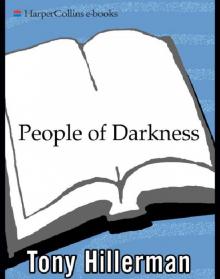 People of Darkness
People of Darkness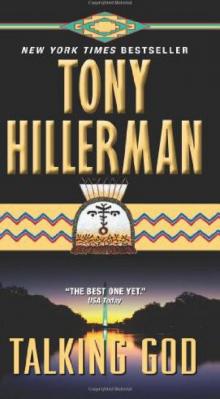 Talking God jlajc-9
Talking God jlajc-9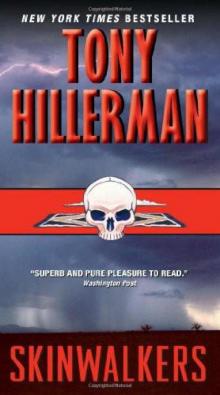 Skinwalkers jlajc-7
Skinwalkers jlajc-7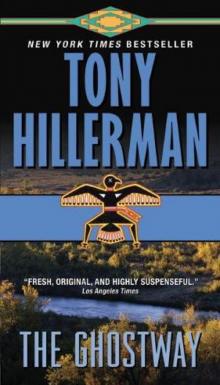 The Ghostway jlajc-6
The Ghostway jlajc-6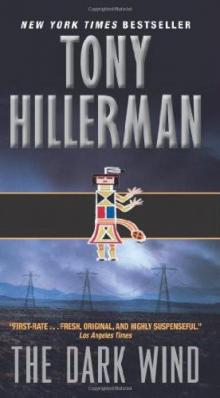 The Dark Wind jlajc-5
The Dark Wind jlajc-5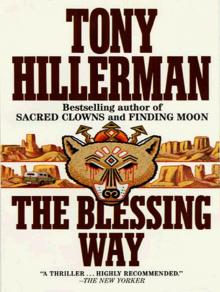 The Blessing Way
The Blessing Way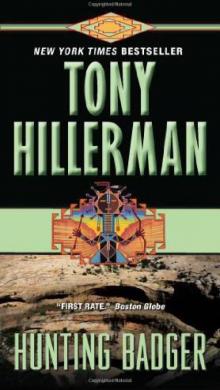 Hunting Badger jlajc-14
Hunting Badger jlajc-14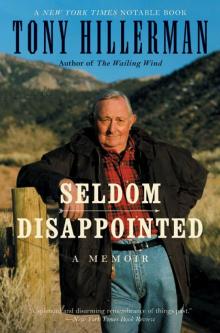 Seldom Disappointed: A Memoir
Seldom Disappointed: A Memoir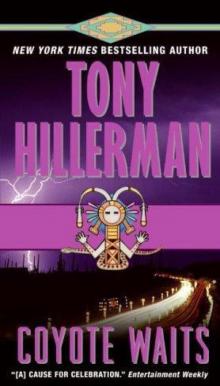 Coyote Waits jlajc-10
Coyote Waits jlajc-10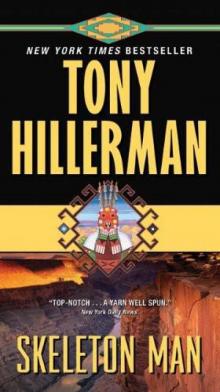 Skeleton Man jlajc-17
Skeleton Man jlajc-17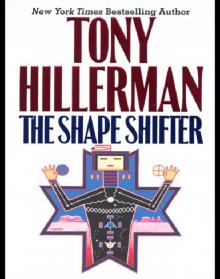 The Shape Shifter
The Shape Shifter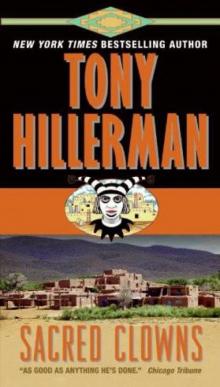 Sacred Clowns jlajc-11
Sacred Clowns jlajc-11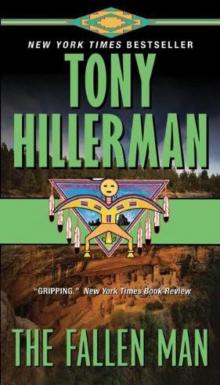 The Fallen Man jlajc-12
The Fallen Man jlajc-12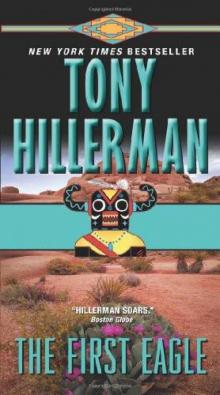 The First Eagle jlajc-13
The First Eagle jlajc-13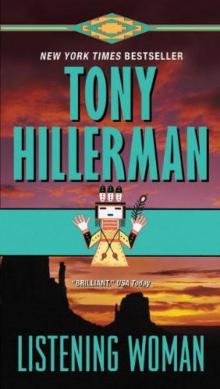 Listening Woman jlajc-3
Listening Woman jlajc-3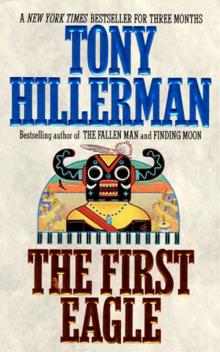 The First Eagle
The First Eagle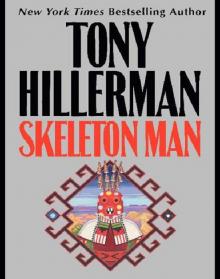 Skeleton Man
Skeleton Man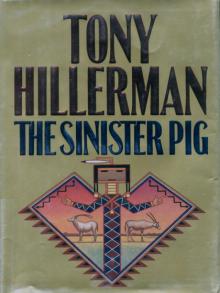 The Sinister Pig jlajc-16
The Sinister Pig jlajc-16 People of Darkness jlajc-4
People of Darkness jlajc-4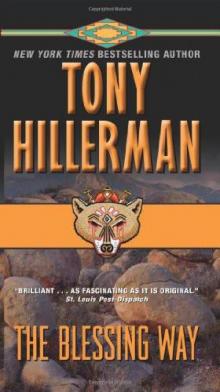 The Blessing Way jlajc-1
The Blessing Way jlajc-1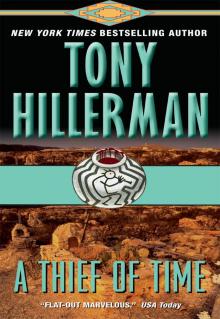 A Thief of Time
A Thief of Time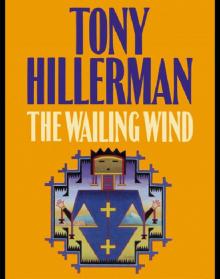 The Wailing Wind
The Wailing Wind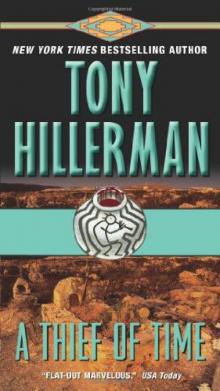 A Thief of Time jlajc-8
A Thief of Time jlajc-8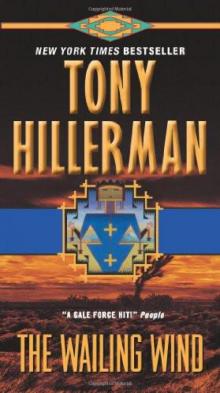 The Wailing Wind jlajc-15
The Wailing Wind jlajc-15 The Shape Shifter jlajc-18
The Shape Shifter jlajc-18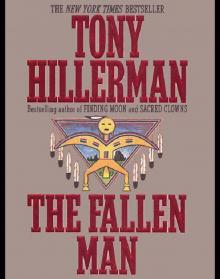 The Fallen Man
The Fallen Man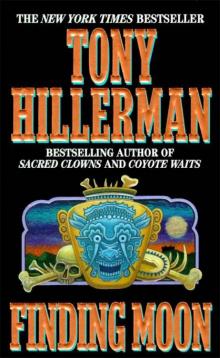 Finding Moon
Finding Moon